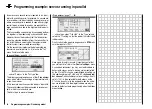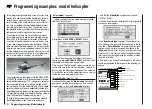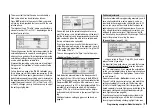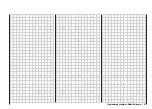
100
Programming example: F3A model aircraft
F3A models belong to the category of powered fi xed-
wing model aircraft designed for competition fl ying. They
may be powered by an internal combustion engine or an
electric motor. Electric-powered models are eligible to fl y
in the international F3A “pattern” class, and also in the
F5A electric aerobatic class.
On page 84, where the section on fi xed-wing model pro-
gramming starts, you will fi nd general notes on instal-
ling and setting up the RC system in a model, and – of
course – this applies equally to F3A models, and there-
fore does not need to be repeated at this point.
If an F3A model is accurately built, it usually exhibits
fl ying characteristics which are almost completely neu-
tral. The perfect aerobatic model has a very smooth but
precise control response, and any movement around
any one of its fl ight axes should not affect the other
axes.
F3A models are fl own using aileron, elevator and rudder
controls. The use of separate servos for each aileron is
almost universal. The fl ying controls are supplemented
by control of motor power (throttle function) and in many
cases a retractable undercarriage. As a result the ser-
vo assignment for channels 1 to 5 is no different to the
fi xed-wing models we have already described.
The auxiliary function “Retracts” is usually assigned
to one of the auxiliary channels 6 to 8. Ideally the re-
tracts are operated using a switch without a centre de-
tent, or the momentary button SW 4. An optional “extra”
– used only if necessary – is mixture adjustment control
for the carburettor. This is generally operated by one of
the two INC / DEC buttons (CTRL 5 or 6) on the trans-
mitter, connected to one of the auxiliary channels not al-
ready in use.
When assigning functions to the auxiliary channels at
the transmitter, it is advisable to ensure that the controls
required are within easy reach, since the advanced ae-
robatic pilot has very little time to think about letting go
of the sticks – especially when fl ying in a competition.
Programming
The basic programming of the transmitter has already
been described in detail in the section starting on page
86, so this section concentrates on tips specifi c to F3A
models.
In the menu ...
»Servo settings«
(page 48)
… you can adjust the servo settings to suit your model.
It has proved advisable to use at least 100% servo tra-
vel, as precision of control can be perceptibly better if
relatively large servo travels are employed. This should
be borne in mind when building the model and desig-
ning the control surface linkages. Any minor corrections
required can be made in the 3rd column during the initi-
al test fl ights.
The next step is to select the menu ...
»Base settings«
(page 38 ... 41)
… and activate the idle trim for Channel 1 (normally
“Idle back”; i.e. full-throttle forward). The digital trim now
works at the idle end of stick travel. The “cut-off trim” en-
ables you to switch immediately from the “motor stop-
ped” position to the idle position you have previously
set just by applying a single “click” on the trim lever (see
page 26).
The remaining settings should be adjusted if required to
suit your personal preferences.
You may fi nd it necessary to assign transmitter controls
to particular inputs to operate the retractable undercar-
riage and carburettor mixture adjustment. This is carried
out in the menu ...
Programming examples: F3A model
7
6
5
4
3
2
1
8/Ba
tt.
CRO-SUPERHET
6
FM
Best.-Nr.
7052
0-282/182-191
MHz/35MHz-B-Band
Made in Malaysia
S C A N
! #
Y-lead, Order No.
3936.11
or
3936.32
Battery
Auxiliary function
Mixture adjustment
Retracts
Right aileron servo
Rudder servo
Aileron servo or left aileron servo
Throttle or speed controller
Elevator servo
Summary of Contents for MX-16S
Page 1: ...1...
Page 17: ...17...
Page 31: ...31 Fixed wing models Installation and connections...
Page 35: ...35 Program description Reserving a new memory...
Page 47: ...47 Base settings Model helicopter...
Page 83: ...83 Fail safe...
Page 89: ...89 Programming examples Fixed wing model...
Page 109: ...109 Programming examples Model helicopter...
Page 112: ...112 112...
Page 116: ...116...
















































